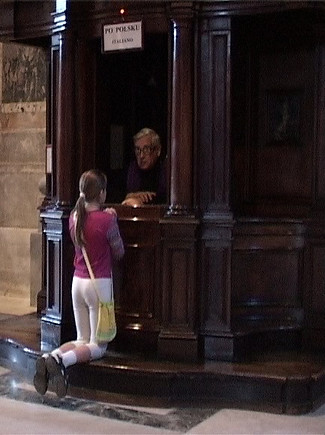IKONI-USKONTOKUVAT
Luonnonuskonnot Hindulaisuus Buddhalaisuus Taolaisuus Kungfutselaisuus Shintolaisuus Juutalaisuus Islam
ORTODOKSINEN KIRKKO KATOLINEN KIRKKO KIRKON ERO 1054 PROTESTANTTISET KIRKOT LUTERILAINEN LIRKKO REFORMOIDUT KIRKOT ANGLIKAANINEN KIRKKO MUITA PROTESTANTTISIA YHTEISÖJÄ SUOMEN KIRKON HISTORIAA
RAAMATTU
ORTODOKSINEN KIRKKO KATOLINEN KIRKKO KIRKON ERO 1054 PROTESTANTTISET KIRKOT LUTERILAINEN KIRKKO REFORMOIDUT KIRKOT ANGLIKAANINEN KIRKKO MUITA PROTESTANTTISIA YHTEISÖJÄ SUOMEN KIRKON HISTORIAA
SAKRAMENTIT JA SAKRAMENTAALIT
PAAVI MITEN PAAVI VALITAAN KATOLINEN KIRKKORAKENNUS FRANCISCUS ASSISILAINEN BIRGITTALAISET VATIKAANI SAKRAMENTIT MESSU



Vatikaanin 2. kirkolliskokouksen mukaan:Sakramenttien tarkoitus on pyhittää ihminen. Niiden kautta ihminen tulee kykeneväksi ottamaan vastaan armon , palvomaan Jumalaa oikein ja harjoittamaan rakkautta. Sakramentti-sana tulee latinan sanasta sacramentum. Vastaava kreikkalainen sana , jota ortodoksinen kirkko käyttää on mysterion.
Katolisessa kirkossa on seitsemän sakramenttia:

Weyden:Kaste, konfirmaatio, rippi
Kaste
Katolisessa kirkossa on käytössä lapsikaste. Vanhempia kehotetaan kohta lapsen syntymän jälkeen viemään lapsi kastettavaksi. Hänelle valitaan katoliseen kirkkoon kuuluva kummi, mutta todistaja voi olla jostain muustakin kristillisestä kirkosta. Jos kastettava on aikuinen, on usein tapana kastaa hänet pääsiäisenä (alkukirkon perinteen mukaisesti)
“Minä kastan sinut Isän ja Pojan ja Pyhän Hengen nimeen”. Näillä sanoilla pappi kastaa lapsen/aikuisen ja valelee pään päälle puhdasta vettä.
Merkitys:
Ihminen saa uuden elämän Kristuksessa ja hän puhdistuu kaikista synneistään myös perisynnistä. Hänet liitetään taivaalliseen sekä maalliseen seurakuntaan. Kaste suoritetaan vain kerran ihmisen elämässä, sillä katolinen kirkko hyväksyy muidenkin kristillisten kirkkojen kasteet.
Kasteen vahvistaminen (konfirmaatio)
Kirkon antaman opetuksen jälkeen kasteen saanut henkilö voidaan konfirmoida. Lapsen katsotaan tulleen siihen ikään, että hän voi olla itse vastuussa omasta hengellisestä elämästään.
Parannus eli rippi
Kirkko katsoo saaneensa Jumalalta valtuutuksen antaa ihmisten syntejä anteeksi. Ihmisen täytyy tuntea katumusta tekojensa takia. Hän kääntyy papin puoleen ja tunnustaa tälle synniksi kokemansa teot. Katolisissa kirkoissa on tätä toimitusta varten erityisiä rippituoleja, joissa on verho katujan ja papin välissä. Rippi voi myös tapahtua muulla tavalla. Pappi antaa katujalle synninpäästön ja määrää sovitustyön, joka voi olla esim paasto, pyhiinvaellusmatkan suorittaminen, jonkun pyhimyksen haudalla vierailu tai muuta...
.jpg)
Eukaristia eli ehtoollinen
Muita nimiä ovat: Herran ateria, leivän murtaminen, Eukaristinen kokoontuminen, Herran kärsimyksen ylösnousemuksen muiston viettäminen, pyhä uhri, messu-uhri, kommuunio
Ehtoolliseen saavat osallistua vain katolisen kirkon jäsenet. Ehtoolliselle tulevan edellytetään paastoavan ainakin tunnin tätä ennen. Seurakuntalaisille jaetaan molemmat ehtoollisaineet leipä ja viini. Katolisessa kirkossa on transsubstantiaatio-oppi, mikä tarkoittaa, että ehtoollisaineet, leipä ja viini, muuttuvat salaisella tavalla Kristuksen ruumiiksi ja vereksi, kun pappi nostaa alttarilla ne ylös, jolloin hellistetään pientä kelloa ja kirkkokansa vaipuu polvilleen. Leipä ja viini ovat muuttuneet Kristuksen ruumiiksi ja vereksi.
Kirkko velvoittaa kaikkia seurakuntalaisia osallistumaan ehtoollisenviettoon ainakin sunnuntaisin ja varsinkin jouluna, loppiaisena ja Kristuksen taivaaseen astumisen pyhänä. Näinä juhlapyhinä ennen ehtoolliseen osallistumista on myös tapana käydä ripittäytymässä.
Weyden: Eukaristia eli ehtoollinen

Vihkimyksen sakramentti
Vihkimyksen sakramenttejä on kolme astetta:
1.Piispuus, 2.pappeus ja 3.diakonaatti.
1.Toiset piispat vihkivät uuden piispan tehtävään. Vihittävä saa pappeuden täyteyden ja sakramentaalisena paimentehtävänä johtaa omaa paikallista hiippakuntaa sen esipaimenena.
2.Piispa vihkii papeiksi vain miehiä, jotka ovat suorittaneet virkaan vaadittavat opinnot ja ovat tehneet naimattomuuslupauksen. Vihkimyksessä pappi saa valtuudet paimentehtäväänsä seurakunnassa, hän voi jakaa sakramentteja ja julistaa vastuullisesti Jumalan sanaa seurakunnassaan.
3.Myös diakonin tehtävään vain miehet saavat vihkimyksen. Miehen tule olla 25 vuotta täyttänyt naimattomuuslupauksen antanut tai 35 vuotta jo naimisissa oleva mies. Heidän tehtävänsä on palvella piispan alaisuudessa esim. erilaisissa lähimmäisenrakkauden, sananjulistuksen ja liturgisissa tehtävissä.
Avioliiton sakramentti
Katolisen käsityksen mukaan avioliitto on muutenkin kuin vain vihkimistä koskevana sakramentti. Avioliitto on tarkoitettu kestämään toisen kuolemaan asti. Kirkko ei hyväksy avioeroa, vaikka maallinen oikeus olisikin myöntänyt sen. Tähän liittyen kirkko ei voi vihkiä eronneita.
Jos katolilainen haluaa solmia avioliiton ei-katolisen kanssa, on hänen pyydettävä siihen erityistä lupaa seurakuntansa papilta. Kirkko toivoo kuitenkin voivansa jollain tavalla osallistua toisen kirkkokunnan järjestämään hääseremoniaan.
Weyden: pappeus, avioliitto, sairaiden voitelu
Rippituoli

Sairaiden voitelun sakramentti
Joskus tätä sakramenttia kutsutaan erheellisesti viimeiseksi voiteluksi. Kuitenkin tämä sakramentti voidaan toimittaa useammankin kierran. Kirkko toivoo, että omaiset ilmoittaisivat hyvissä ajoin sukulaisensa vakavasta sairaudesta ja kutsuisivat papin sairastuneen luokse. Pappi rukoilee sairastuneen puolesta ja voitelee sairaan tähän tarkoitetulla öljyllä.
SAKRAMENTAALIT
Sakramentaalit ovat kirkon asettamia toimituksia erilaisiin ihmisen elämän tarkoituksiin, niillä voidaan pyhittää esim ihmisille hyödyllisiä esineitä , siunata uusi koti, uusi elämäntilanne, rakennusten siunaaminen käyttöön, hautaan siunaaminen, pahan karottaminen (eksorsismi).
Toimitukseen kuuluu aina rukous ja tilanteen mukaan kätten päälle paneminen, veden vihvominen, ristinmerkin tekeminen.
Lähteet: Jaanu-Schröder 2008 Lukion katolinen uskonto (s.116-118) Helsinki: Edita Prima oy
https://www.katolinen.net/kaste.html
https://www.katolinen.net/vahvistus.html
https://www.katolinen.net/eukaristian-sakramentti.html
https://www.katolinen.net/parannuksen-sakramentti.html
https://www.katolinen.net/sairaiden-voitelu.html
https://www.katolinen.net/vihkimys.html
https://www.katolinen.net/avioliitto.html

